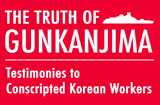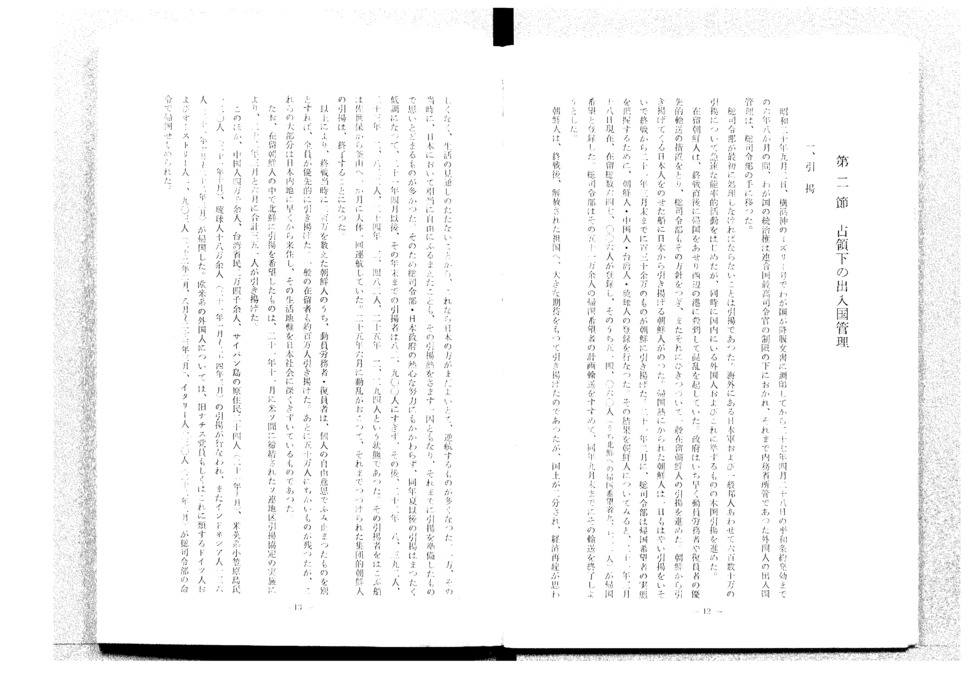Immigration Control Report: Immigration Control and its Current Situation 1959
Section 2 Immigration Control under Post-war Occupation
- Author
Page 1
Section 2 Immigration Control under the Occupation
- Repatriation
During the six years and eight months from September 2, 1945, when the Japanese Instrument of Surrender was signed aboard the USS Missouri offshore Yokohama, until the Treaty of Peace with Japan came into force on April 28, 1952, Japanese sovereignty was under the restrictions of the Supreme Commander for the Allied Powers (SCAP), and immigration control, which had been under the jurisdiction of the Ministry of Home Affairs up until that time, was transferred to the General Headquarters (GHQ).
The first issue which the GHQ had to deal with was repatriation. The GHQ rapidly began efficient activities for the repatriation of the six million and several hundred thousand Japanese military personnel and civilians overseas, and simultaneously advanced the repatriation of foreigners and equivalent persons in Japan back to their home countries.
Just after the war ended, Koreans residing in Japan inundated western ports as they rushed to return to Korea, causing chaotic conditions. The government immediately took measures for the priority transportation of demobilized laborers and soldiers and the GHQ also maintained this policy, and then advanced the repatriation of the Korean residents who were civilians. Koreans being repatriated from Japan rode on ships that carried Japanese being repatriated from Korea. More than 1.3 million Koreans repatriated between the end of the war and the end of March 1946, driven by a passion to return home as soon as possible. In February 1946, the GHQ conducted registration of Koreans, Chinese, Formosans, and Ryukyuans in an effort to grasp the conditions of persons desiring repatriation. The results show that as of March 18, 1946 there were a total of 647,006 Koreans residing in Japan registered, of which 514,060 (including 9,701 who desired to return to North Korea) desired to return to Korea. The GHQ pushed ahead the planned transportation of these more than 510,000 Koreans who desired repatriation, aiming to complete that transportation by the end of September that year.
After the war ended, Koreans repatriated with great expectations of their liberated fatherland, but the national territory had been divided into two, economic recovery was not proceeding well, and many Koreans returned to Japan seeing no prospects for making a living in their homeland and judging that conditions were better in Japan. On the other hand, the fact that Koreans were able to behave rather freely in Japan at that time was also one factor that cooled the fever for repatriation, and many Koreans who had prepared to repatriate changed their minds. For that reason, despite enthusiastic efforts by the GHQ and the Japanese government, repatriation turned absolutely dull from the summer of 1946. The number of Koreans who repatriated between April 1946 and the end of that year was just 82,900, with 8,392 in 1947, 2,822 in 1948, 3,482 in 1949, and 2,294 in 1950. The ships which carried those repatriated generally sailed from Sasebo to Busan once per month. A disturbance occurred in June 1950, and that marked the end of the organized repatriation of Koreans which had continued up until that time.
To summarize, among the two million Koreans residing in Japan when the war ended, all the demobilized laborers and soldiers were repatriated on a priority basis, aside from those who chose to remain in Japan of their own free will. Approximately one million Korean civilians residing in Japan were also repatriated. Nearly 500,000 Koreans remained, but most of those had lived in Japan for many years and built up their foundations for life with deep roots in Japanese society.
Incidentally, among the Koreans residing in Japan, a total of 351 who desired repatriation to North Korea were repatriated in March and June 1947 through implementation of the agreement on repatriation from Soviet-controlled areas signed by the U.S. and the U.S.S.R. in November 1946.
In addition, there were repatriations of more than 41,000 Chinese and over 24,000 Formosans, as well as 24 aboriginal residents of Saipan (October 1946), 120 descendants of original American and European Settlers of the Ogasawara Islands (October 1946), over 180,000 Ryukyuans (from January 1946 through March 1949), and 136 Indonesians (from October 1946 through March 1947). Regarding foreigners of European or American origin, the GHQ ordered repatriation of 1,903 Germans and Austrians (from February 1947 through March 1948) who were former members of the Nazi Party or equivalent persons and 130 Italians (February 1947).



